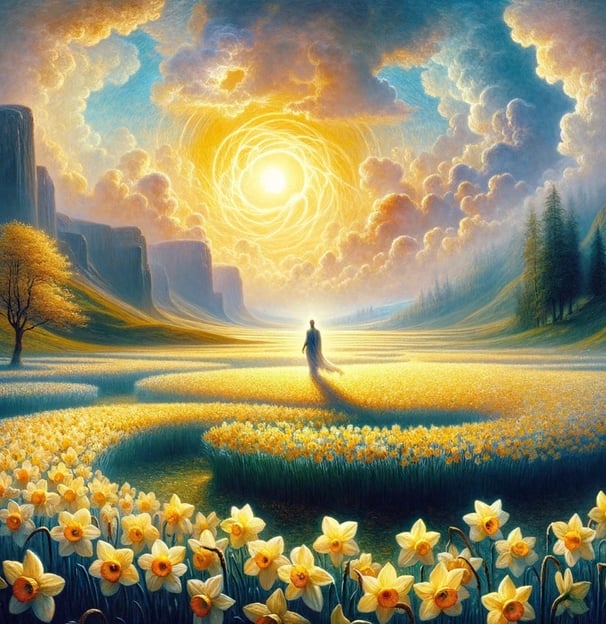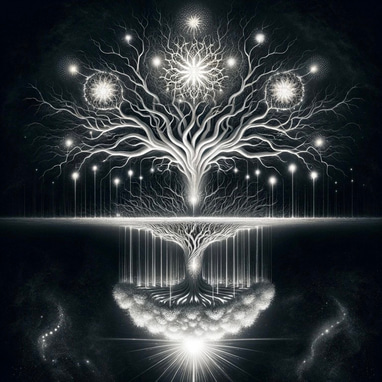Enlightenment Through Nature: Integrating Wordsworth with Eastern Philosophy
This blog article, titled "Enlightenment Through Nature: Integrating Wordsworth with Eastern Philosophy," presents a compelling exploration of William Wordsworth's "Daffodils" in dialogue with the spiritual teachings of the Bhagavad Gita and the Upanishads. It delves into how Wordsworth’s portrayal of a simple walk among nature transcends into a narrative of spiritual awakening and enlightenment, reminiscent of the Indian journey from darkness to light ("tamaso ma jyothirgamaya"). The article breaks down the poem stanza by stanza, aligning its themes with Eastern philosophical concepts and highlighting the transformative power of nature as a universal bridge to higher consciousness. It's a thought-provoking read for anyone interested in the intersection of literature, spirituality, and the enduring human quest for understanding and connection.
Shary Krishna B S
1/25/20242 min read




The timeless poem “I Wandered Lonely as a Cloud,” also known as “Daffodils,” by William Wordsworth, captures the essence of the Romantic era with its deep appreciation for nature and the individual experience. It isn’t merely an ode to the beauty of the natural world; it’s a gateway to spiritual and philosophical discovery. This poem serves as a “sethu,” a bridge, to deeper realms of understanding, echoing the enlightening journey from “tamaso ma jyothirgamaya” - a movement from darkness to light that is central to Indian philosophy.
In the first stanza, Wordsworth’s solitary cloud symbolizes the journey of the soul. As the speaker wanders ‘o’er vales and hills,’ we witness a metaphor for the soul’s quest for meaning, reminiscent of the soul’s journey (samsara) in the Bhagavad Gita. This solitary wandering is more than physical; it is a profound internal journey, highlighting the Romantic era’s focus on emotion and personal experience as means to greater insights (Abrams, 1971).
The poem’s second stanza describes an epiphany through the sudden, joyous sighting of a multitude of daffodils. Here, Wordsworth captures a moment of revelation, much like the light of knowledge (vidya) piercing through ignorance (avidya), as described in Hindu philosophy. The daffodils’ dance, ‘fluttering and dancing in the breeze,’ is a dance of life and joy, a reflection of the divine spark that animates all creation (Hartman, 1987).
Wordsworth’s own transformation from a state of loneliness to one of jubilation mirrors the philosophical journey from darkness to light. The daffodils as a metaphor for “purusha,” or the eternal consciousness, and the speaker’s uplifted mood after encountering them reflects a spiritual awakening, aligning with the concept of enlightenment in the Upanishads (Zimmer, 1951).
In the final stanza, the enduring impact of this communion with nature is evident. The memory of the daffodils brings joy in solitude, symbolizing the transformation of the inner self. This experience underscores the belief in nature’s power to elevate the human spirit, resonating with Wordsworth’s view on the transformative potential of nature (Gill, 1990).
This article reveals how Wordsworth’s “Daffodils” is not just a simple appreciation of nature but a rich, multifaceted poem that encapsulates profound philosophical truths about human existence and our connection to the world. By drawing parallels to the spiritual enlightenment depicted in the Bhagavad Gita and the mantra from the Upanishads, we see the universal quest for understanding and the transformative power of nature’s beauty.
The poem, through its vivid imagery and emotional depth, becomes a vehicle for the soul’s journey from ignorance to an enlightened state, mirroring the essence of “tamaso ma jyothirgamaya.” Through this integration of Western literature and Eastern philosophy, we gain a deeper appreciation of the interconnectedness of human experience and the universal search for truth.
References:
Abrams, M. H. (1971). The Mirror and the Lamp: Romantic Theory and the Critical Tradition. Oxford University Press.
Hartman, G. H. (1987). Wordsworth’s Poetry, 1787-1814. Yale University Press.
Zimmer, H. (1951). Philosophies of India. Princeton University Press.
Gill, S. (1990). William Wordsworth: A Life. Clarendon Press.
Yogananda SS. God Talks with Arjuna: The Bhagavad Gita. 1st Indian Paperback ed. Kolkata: Yogoda Satsanga Society of India/Self-Realization Fellowship; 2002. p. 669-74.
Wordsworth W. Wordsworth: ‘Daffodils’ and Other Poems. London: Michael O’Mara Books; 2016.
Enlightenment Through Nature: Integrating Wordsworth with Eastern Philosophy




My post content


